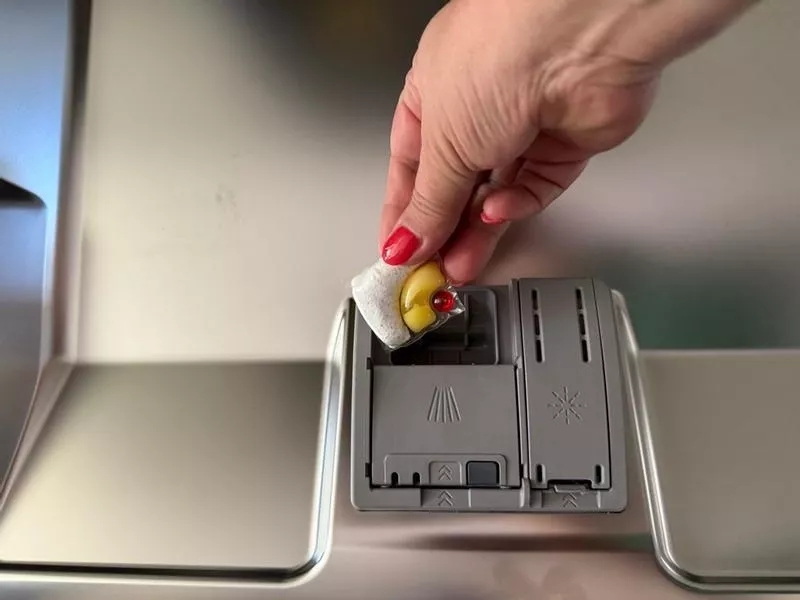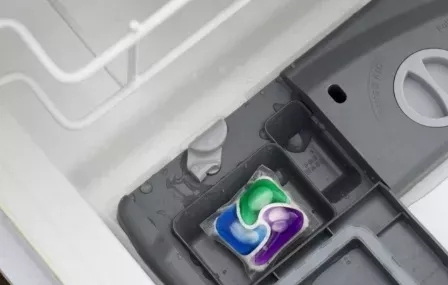Dongguan UFine Daily Chemical Co.,Ltd.
- All
- Product Name
- Product Keyword
- Product Model
- Product Summary
- Product Description
- Multi Field Search
Views: 222 Author: Tomorrow Publish Time: 10-18-2025 Origin: Site











Content Menu
● Why Placement of Cascade Pod Matters?
● Where Does the Cascade Pod Go in Dishwasher?
>> 1. Dishwasher Detergent Dispenser
>> 2. Inside the Bottom Dishwasher Rack (Alternative)
>> 3. Special Considerations for Dishwashers Without a Detergent Dispenser
● How to Use Cascade Pods Correctly
● Benefits of Using Cascade Pods
● Troubleshooting Common Issues
>> Pods Sticking Together in Storage
● Can Cascade Pods Be Used in All Dishwashers?
● Environmental Considerations
● FAQ
>> 1. Where exactly should I put the Cascade pod in my dishwasher?
>> 2. Can I put the Cascade pod directly on the bottom rack or somewhere else?
>> 3. What happens if the pod doesn't fully dissolve?
>> 4. Can I use more than one Cascade pod per cycle?
>> 5. Are Cascade pods safe to use with all dishwasher types?
When it comes to cleaning dishes in a dishwasher, using the right detergent and placing it correctly is essential. Cascade pods have become a popular choice for many because of their convenience and ability to clean effectively without the mess of powders or liquids. However, a common question among users is: where exactly does the Cascade pod go in the dishwasher for best results? This article provides a comprehensive guide on proper usage, placement, and benefits of Cascade pods to help you optimize your dishwashing routine.

Cascade pods are pre-measured detergent capsules designed to simplify the dishwashing process. Each pod contains a combination of detergents, enzymes, and rinse agents sealed inside a water-soluble film. This design ensures the pod dissolves at the right time during the dishwasher cycle, releasing cleaning agents that break down food residue, grease, and stains. The pods are formulated to work in varied water types, including hard and soft water, providing consistent cleaning power.
Unlike traditional powder or liquid detergents, Cascade pods require specific placement to ensure they dissolve properly and effectively clean the dishes. Incorrect placement can lead to pods not dissolving fully, leaving residue or detergent spots on dishes, or poor cleaning performance. Proper placement ensures the pod interacts with water and dishwasher jets at the right moments, optimizing the entire washing process.
Proper placement also helps avoid clogging or damage to your dishwasher parts and prevents detergent wastage. Cascade pods are designed for controlled release inside the detergent compartment, where water flow triggers the dissolving process in a manner aligned with the dishwasher's wash cycles.
The primary and recommended location for placing a Cascade pod is the dishwasher's detergent dispenser. This is a small compartment with a spring-loaded or manual door on the inside of the dishwasher door. The detergent dispenser is designed to hold and release detergent at specific times during the wash cycle.
- Place the Cascade pod inside the detergent dispenser compartment.
- Close the dispenser lid securely to keep the pod in place.
- Start the dishwasher cycle as usual.
Placing the pod here ensures it stays dry until the washing cycle begins, allowing it to dissolve gradually and clean effectively. The dispenser mechanism is engineered to open at the optimal time during washing to release the pod's contents precisely when water and temperature conditions are best for cleaning.
Some users wonder if placing the pod directly inside the dishwasher tub, usually on the bottom rack, is acceptable. While certain brands or dishwasher models may tolerate this, placing Cascade pods in the bottom rack is generally not recommended.
- The pod may dissolve too early or unevenly.
- Detergent may spill before the cycle begins.
- Cleaning performance can be compromised.
Pods placed directly in the dishwasher might not have controlled exposure to water jets or timing, which can lead to incomplete dissolution or detergent residue on dishes. Moreover, detergents in loose contact with dishes may fail to distribute evenly.
Therefore, the detergent dispenser remains the best and recommended location.
Some portable or older dishwasher models may lack a built-in detergent dispenser. In such cases:
- Place the Cascade pod where water can freely reach it early in the wash cycle.
- Consult the dishwasher's manual for recommendations.
- Avoid placing the pod in areas where it might remain dry or get trapped behind dishes.
This manual placement requires care to avoid premature dissolving or blockage.
1. Check dishwasher instructions: Different dishwasher models have different detergent dispensers; consult your dishwasher manual before use.
2. Load dishes properly: Space out dishes to allow water jets to reach all surfaces and the detergent dispenser.
3. Place the pod in detergent dispenser: Put one pod per wash cycle.
4. Close the dispenser door: Make sure it snaps shut.
5. Select the appropriate wash cycle: Choose based on the soil level.
6. Start the dishwasher: The dispenser door will open automatically during the wash, releasing the pod.
- Do not remove the pod's protective film; it is designed to dissolve completely.
- Do not overload the dishwasher; overcrowding prevents proper cleaning.
- Avoid adding any extra detergent when using Cascade pods.
- Store pods in a dry location to prevent them from sticking together.
- Use pods compatible with your dishwasher's temperature settings; very cool water may affect dissolution.
- Regularly clean the dishwasher's filter and spray arms to maintain efficient water flow.

- Placing pods directly in the bottom of the dishwasher, which can result in early dissolution or detergent residue.
- Using more than one pod per cycle unnecessarily, increasing detergent residue and waste.
- Ignoring dishwasher detergent manufacturer instructions, which may vary.
- Loading dishes in a way that blocks the detergent dispenser and prevents pod release.
- Using pods in very cold or short wash cycles that do not allow proper dissolution of the pod film and contents.
- Using the pods without checking water temperature or hardness, affecting performance.
Cascade pods bring a range of benefits, making them a preferred choice for many dishwashing routines:
- Convenience: Pods eliminate the need to measure detergent or deal with messy powders and liquids.
- Consistent cleaning: Each pod delivers a pre-measured amount for optimal results, avoiding under or overdosing.
- Less mess: The pod's water-soluble film prevents detergent spills or powder dust around your kitchen.
- Efficiency: Cascades contain specialized enzymes and built-in rinse aids that boost cleaning power and prevent spotting.
- Safety: Adsorbed packaging and single-use dosing reduce exposure to harsh detergents.
- Eco-conscious packaging: Designed to reduce plastic waste compared to many liquid detergent containers.
- Compatibility: Work well with most modern dishwasher cycles and water types.
- Verify that the detergent dispenser door is opening freely and not blocked.
- Use the pod only in the detergent dispenser, not loose inside the dishwasher.
- Ensure water temperature is appropriate — typically at least 120°F (49°C).
- Avoid very short or eco-friendly cycles that reduce wash time and temperature.
- Regularly clean filters, spray jets, and the detergent dispenser to avoid blockages.
- Confirm pods are placed correctly inside the detergent dispenser.
- Avoid overcrowding or blocking the detergent dispenser vents.
- Consider water hardness; use a water softener or additional rinse agent if necessary.
- Clean the dishwasher regularly to prevent buildup.
- Choose wash cycles suitable for soil levels and dish types.
- Store your Cascade pods in a cool, dry area away from humidity.
- Keep pods in their original packaging or a sealed container.
- Avoid exposing pods to moisture or steam, which causes them to clump or dissolve prematurely.
Cascade pods are formulated to work efficiently in most standard modern dishwashers. However, here are some points to consider:
- Older dishwasher models or those without a detergent dispenser may not provide optimal pod performance.
- Some compact or portable dishwashers may require special detergent forms.
- Cascade pods work best in cycles that provide adequate water temperature and cycle length.
- Always review your dishwasher manufacturer's detergent recommendations.
- Avoid pods in certain specialty wash cycles designed for delicate glass or quick rinses, as these may affect pod performance or dissolution.
Cascade pods use water-soluble film that dissolves fully, reducing chemical residues and lessening plastic waste compared to bottled detergents. However, environmental impact also depends on:
- Dishwasher water and energy usage.
- Proper dishwasher maintenance to optimize efficiency.
- Using eco-friendly wash cycles where possible.
- Proper disposal of packaging.
Consumers are encouraged to combine Cascade pods with energy and water-saving dishwasher habits for a greener clean.
Cascade pods simplify the dishwashing process by offering convenience, consistent cleaning, and mess-free detergent handling. The key to maximizing their effectiveness is placing them appropriately inside the detergent dispenser compartment of your dishwasher. Avoid placing them directly on dishwasher racks to prevent premature dissolving or poor cleaning results. Proper use guarantees sparkling clean dishes and hassle-free washing cycles every time. Following recommended loading, cycle selection, and storage guidelines will ensure you get the best performance and prolong the life of both your dishwasher and your dishes.

Place the Cascade pod inside the dishwasher's detergent dispenser compartment and close the lid securely before starting the cycle.
While some might place pods on the bottom rack, it is not recommended as it can cause the pod to dissolve too early or unevenly, reducing cleaning effectiveness.
If the pod doesn't dissolve fully, check that your water temperature is high enough, the detergent dispenser opens properly, and you are using the correct wash cycle.
No, using more than one pod per cycle is unnecessary and may cause residue buildup or poor cleaning performance.
Cascade pods are generally safe for most modern dishwashers, but check your dishwasher manual for any specific detergent recommendations.